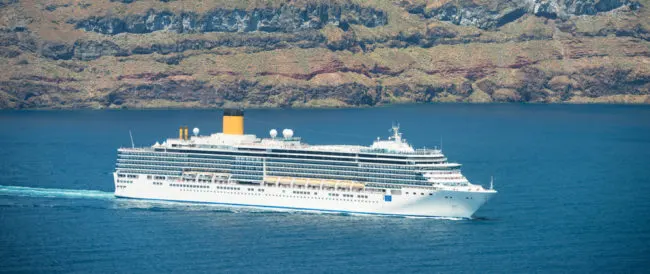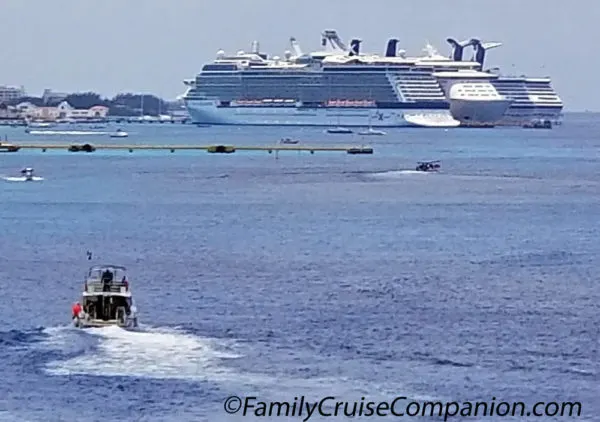Due to their enormous size, cruise ships require an astonishing amount of power to keep them moving through the water. While cruise ships are generally not designed for speed, they do possess the ability to travel at higher speeds than their average cruising speed to escape adverse weather or assist other ships needing help.

So, how fast does a cruise ship go? Cruise ships travel, on average, around 20 knots per hour. Knots refer to nautical miles, which are approximately 1.15 miles on land. So that works out to an average speed of about 23 MPH. While most cruise ships can reach speeds up to 30 knots, which is almost 35 MPH, they will rarely reach these speeds except in emergencies. Keep reading to find out why and what factors contribute to more or less speed, and info about the fastest cruise ships ever. Plus, learn the answer to the all-time favorite kids’ question – how does such a humongous ship stay afloat?
Typically, How Fast Does a Cruise Ship Go?
The speed of ships is measured in knots per hour. One knot is equal to one nautical mile, which equates to 1.15 miles on land. The majority of cruise ships will typically travel at around 20 knots per hour.
At first blush, that seems kind of slow. It’s basically the same speed you find driving through a school zone. But this is the most efficient speed at which the ship can travel. Traveling at faster speeds requires more energy and more fuel. Due to the size of cruise ships, the amount of fuel expended is extremely significant.
As a result, any speed increases will result in significant increases in fuel consumption. The size of a cruise ship will naturally affect its speed, and a larger ship will require more energy to travel quickly. While most cruise ships can reach speeds up to 30 knots per hour, they will seldom travel at these speeds due to the high consumption of fuel and associated wear and tear on the ship.
The ship’s speed is also determined by the ship’s itinerary, current weather conditions, and the presence of potential emergencies.
No matter the potential top speed, ships rarely travel at maximum speed. These limited occasions include the initial testing of the ship when it’s tested for efficiency and ability to cope in any possible situation at sea. Ships will also utilize maximum speed when escaping storms or other adverse weather conditions, or rushing to the aid of another ship in distress.
What’s The Fastest Speed Achieved By a Cruise Ship?
The fastest ever recorded speed achieved by a cruise ship was, in fact, by an ocean liner called the SS United States. That ship was built when the speed of ships was critical because ocean liners were designed to transport passengers as quickly as possible across the Atlantic ocean. The SS United States reached a top speed of 39 knots (which is about 45 MPH).
While this occurred in 1952, it remains the fastest ship on record to cross the Atlantic ocean in either direction. In the subsequent decades, the focus shifted away from creating faster ships. Airplane travel became more commonplace, and cruise ships were intended to move along at a more leisurely pace from port to port.
How Are Cruise Ships Powered?
Regardless of speed, cruise ships need some kind of power source to move at all. As you can imagine, cruise ships require enormous power to keep the ship moving forward while simultaneously powering all the electrical features of the ship. The air conditioning system can be particularly demanding.
Cruise ships are usually powered by gas turbines, diesel-electric, or diesel engines. These provide both the propulsion needed to move the ship and the electrical power required to keep all amenities running throughout the ship at all times. (Loss of power on a cruise ship can lead to dire situations quickly.)
Diesel engines are probably the most common, with the diesel fueling the pistons and crankshaft attached to the propellor, in turn moving the ship forward.
Diesel-electric engines carry the power to the generators that provide electricity to turn the propellors while simultaneously powering the lights, appliances, air-conditioning, and other amenities onboard the ship.
The diesel generators on a ship are multiple in number, with an average cruise ship featuring around 5 or 6 enormous generators housed in their own space called the Diesel Generator room.

What Keeps The Ship Afloat?
When folks step on a giant mega ship like Odyssey of the Seas, they often wonder how such a vessel manages to float. (At least our kids do!) Cruise ships are kept afloat through a combination of buoyancy, water displacement, design, and materials. The short answer is that because the ship displaces the equivalent amount of water compared to its own mass, it will not sink.
This means that the downward force of the ship’s mass exerted on the water is counteracted by the upwards push on the hull of the ship from the water. As a result, the combination of the downwards force of the ship and the upwards force of the ocean can keep the ship afloat.
This stems from the ancient principle of Archimedes, where he discovered that an object floats when the weight of the water displaced by the object is equal to the total weight of the object. This is because the fluid can push back with force equal to what is being displaced.
Because water can’t be compressed (unlike air), the combined simultaneous upwards and downwards forces create buoyancy for the ship. Compare the way that a submarine operates: The reason submarines do not typically float on the surface of the ocean is because they are equipped with special tanks that can be filled with water or air depending on whether the vessel needs to float to the top of the ocean or dive to the bottom. When the submarine needs to dive, the special tanks fill with water which makes the submarine more dense than the surrounding water.
So, a cruise ship’s density plays a significant role because the average density of the ship is significantly lower than the average density of water. The ship’s designers ensure that this is the case throughout the ship’s design. The ship maintains sufficient open air space regardless of how full the ship might be. Thus, the density of the ship remains below that of the water.
Another factor that helps a cruise ship stay afloat is its wide, u-shaped hull that helps to ensure buoyancy for the enormous vessel.
What’s The Fastest Cruise Ship In The World?
While the SS United States holds the record with a top speed of 39 knots, numerous other cruise ships have had significant speed.
The Queen Mary 2, part of the Cunard line, has a top speed of 30 knots, making it the fastest cruise ship currently in operation. The Rotterdam of the Holland America Line (built-in 1997) has a top speed of 25 knots, which is pretty much the average across most other cruise ships.
Note that newer ships do not necessarily have higher speeds. As ships have grown to mega sizes and the focus has moved more towards leisure and away from efficient transport, the need for faster ships has diminished.
Conclusion
On average, cruise ships can travel at 20 knots, with some traveling up to 30 knots. However, cruise ships rarely travel at top speeds.
